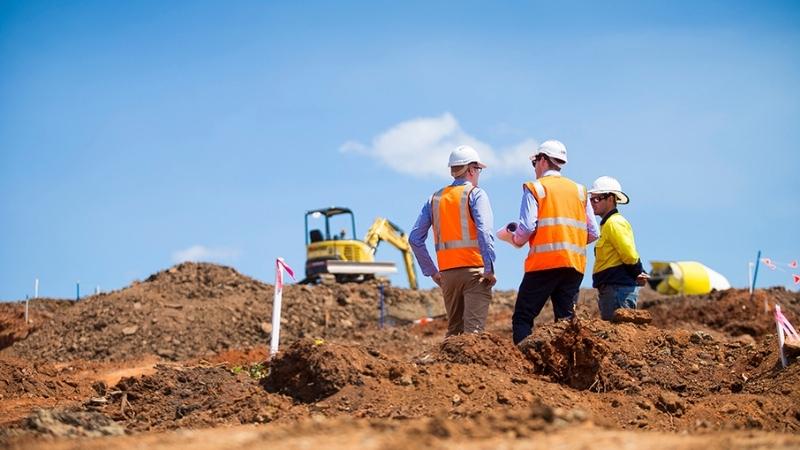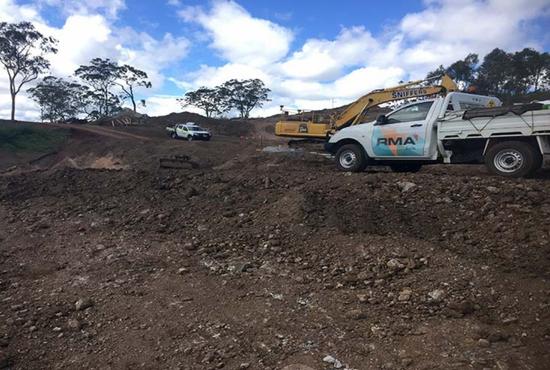


While it might seem like these fixtures pop up overnight, these projects have, in fact, been in development for months and sometimes even years. From site selection right through to the final inspection (not to mention all the hands it passes through in between), the construction process covers far more than just the building phase alone. Our company’s dynamic and innovative range of services means that we have the privilege of having a unique insight into the wider construction and engineering process. That’s why this month, we’re taking a look behind-the-scenes of the construction life cycle and where our team at RMA Soils + Geotechnical fit in (and add value to) that process. It’s imperative that all projects follow the same general process, in order to comply with the Queensland Building and Construction Commission, the respective local government planning scheme and the relevant Australian regulatory standards, and to maximise construction safety.
Prior to the commencement of any construction project, a broadscale overview (or ‘concept’) is established. This usually entails the development of a scope and brief, as well as the commencement of a feasibility study. Feasibility studies determine whether or not the project is financially viable and whether or not there’s adequate demand for the infrastructure. For minor projects, the feasibility study is likely to be quite informal. For large-scale projects however, particularly those sanctioned by government departments, a more formal feasibility study is typically required, and more specifically, one that evaluates the geotechnical and environmental impacts of the project. These Government-mandated feasibility studies generally also involve extensive community consultation.
During the concept phase a business plan is also produced, which outlines a cost/benefit analysis, establishing time frame goals and identifying regulatory frameworks. Around the same time the feasibility and business plan is being developed, the Project Manager (which could be either in-house or externally contracted) begins building the project timeline and tendering for designers and engineers.
Our team of Geotechnical and Geological professionals provide critical support during this stage of the process, by helping with site selection, terrain evaluation and land capability, salinity and acid sulphate assessments, slope risk assessments, geotechnical hazard identification and soil assessments. The important information we garner from our tests and assessments during this phase helps inform the early design stage and project feasibility, providing insight into the potential ground conditions and what is possible in terms of geotechnical impact on the proposed development. The results we provide highlights crucial information for risk mitigation and sustainability of the project concept.
Towards the conclusion of the concept phase, a definitive decision needs to be made as to whether or not to proceed with the project in its original form, to redesign the concept and then proceed, or to abandon the project altogether. The key decisions made during the concept phase determine how successful the subsequent construction stages will be further on in the process.
Once the project has been fully conceptualised and a designer has been selected, the next stage in the geotechnical space is to carry out a more comprehensive investigation across the proposed site that will inform detailed civil and structural design considerations. Quality geotechnical data is often the key to a project running on time and within budget. Once that information is presented to the project team, they then commence early drawings that help sharpen the scope of the project. The design stage is where the vision of the client and the reality of possibility meet. Designers and engineers model and draw tangible construction plans that inevitably pave the way for obtaining a development application (DA) from the relevant Government body (usually a local Council), or accredited private certifier who acts on their behalf.
If the government authority refuses development approval, or approves the application with strict conditions, the client may choose to redesign the concept in order to comply with the outcome of the DA, or they may choose to lodge an appeal in court.
Once the construction plans are finalised and the DA is approved, the tendering process for contractors and construction companies begins, and bid materials (information and drawings that these businesses need in order to submit a bid for the work) are produced.
Throughout the design stage, our team at RMA Soils + Geotechnical provide support by providing comprehensive, ongoing professional advice backed by our in house RPEQ signatory and NATA endorsed laboratory testing and reporting to add to quality documentation for submission to the relevant Government department where applicable.
Most projects, especially government-sanctioned ones, make their selections based on the submissions they receive during the tender process. While the selections can be made at almost any stage of the construction process, it typically happens once the DA has been approved and more detailed information and documentation becomes available. Potential builders, or contractors, are invited to tender for the contract to fill the role of Principal Contractor for the project. Once the deadline passes and all of the bids (tenders) have been submitted, the options are then evaluated based on price, quality, experience, timeframe and choice of subcontractors. Eventually, the main contracts are awarded and the project team is finalised.
The project team is usually comprised of a contract administrator who ensures that the necessary people have accurate information about the project contract; a superintendent who oversees the progression throughout the entirety of the construction project; a project manager who has boots on the ground, supervising and coordinating all on-site schedules, deliveries and other activity; a geotechnical engineer who conducts the site inspection, identifies any geotechnical hazards, provides advice on safety and compliance regulations and works alongside a soil technician to determine appropriate construction methodology and inspection and testing plan (ITP) for the project (which addresses any hazards and meets relevant specifications); and a range of specialty subcontractors who complete very specific aspects of the build (e.g. electricians, painters, surveyors).
This is a pretty straightforward step in the process – the procurement stage is simply where the project team acquires all the tools and equipment needed to complete the construction project (either by purchasing or hiring). For a construction project, that means sourcing the labour, equipment, and building materials.
The main considerations in this stage are budget and time sensitivity.
The construction phase is where the magic really happens. It’s time to break ground – literally! The project finally transitions from plans to reality.
For a typical project, this involves:
During construction, the team at RMA Soils + Geotechnical continue our fundamental role by providing construction materials testing, geotechnical inspections and advice during construction (including Level 1 supervision for earthworks, compaction testing for trench backfill/road pavements, stability assessments for deep excavations and subgrade strength inspection for foundations). The work we do during this phase is essential to identifying potential non-conformance to the specifications and rectifying it early, all the way through to the project meeting its intended design life.
Once the building component is complete, there’s still some work to be done in order to fully finalise the project. Final walkthrough inspections by the client and the relevant Government department are essential, so that all stakeholders agree that the project was completed in line with the design brief and that the building is operating functionally. For most projects, particularly land development projects, the next step will be to conduct a final survey, submit all quality documentation (including our NATA endorsed test reports) to the relevant authorities seeking approval to enter into the ‘on maintenance period’ (where any defects can be rectified before the client or authority takes possession of the asset) and final approval or ‘off maintenance’ status is achieved.
As you can see, there is a huge amount that happens behind-the-scenes of a construction project. RMA Soils + Geotechnical provides crucial services across various stages of the build, a lot of which provides fundamental information that helps the project come to life in a safe and sustainable way. We’re proud of the footprint we’ve made across Queensland on projects that are helping to shape the modern landscape. If you’ve got an upcoming construction project on the horizon, we’d love to partner with you! We’re passionate about providing professional service and quality work. You can reach us at enquiries@rmasoils.com.au or join our community on LinkedIn, where we’re sharing all the exciting work we’ve been doing.
